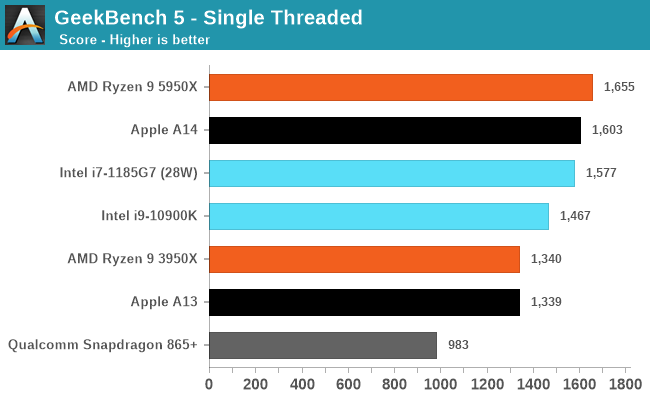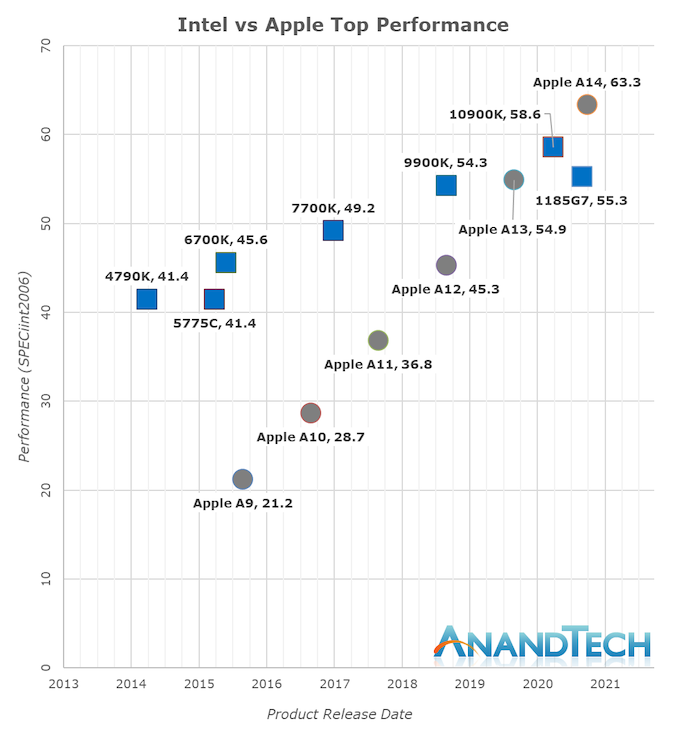Apple Announces The Apple Silicon M1: Ditching x86 - What to Expect, Based on A14
by Andrei Frumusanu on November 10, 2020 3:00 PM EST- Posted in
- Apple
- Apple A14
- Apple Silicon
- Apple M1
From Mobile to Mac: What to Expect?
To date, our performance comparisons for Apple’s chipsets have always been in the context of iPhone reviews, with the juxtaposition to x86 designs being a rather small footnote within the context of the articles. Today’s Apple Silicon launch event completely changes the narrative of what we portray in terms of performance, setting aside the typical apples vs oranges comparisons people usually argument with.
We currently do not have Apple Silicon devices and likely won’t get our hands on them for another few weeks, but we do have the A14, and expect the new Mac chips to be strongly based on the microarchitecture we’re seeing employed in the iPhone designs. Of course, we’re still comparing a phone chip versus a high-end laptop and even a high-end desktop chip, but given the performance numbers, that’s also exactly the point we’re trying to make here, setting the stage as the bare minimum of what Apple could achieve with their new Apple Silicon Mac chips.

The performance numbers of the A14 on this chart is relatively mind-boggling. If I were to release this data with the label of the A14 hidden, one would guess that the data-points came from some other x86 SKU from either AMD or Intel. The fact that the A14 currently competes with the very best top-performance designs that the x86 vendors have on the market today is just an astonishing feat.
Looking into the detailed scores, what again amazes me is the fact that the A14 not only keeps up, but actually beats both these competitors in memory-latency sensitive workloads such as 429.mcf and 471.omnetpp, even though they either have the same memory (i7-1185G7 with LPDDR4X-4266), or desktop-grade memory (5950X with DDR-3200).
Again, disregard the 456.hmmer score advantage of the A14, that’s majorly due to compiler discrepancies, subtract 33% for a more apt comparison figure.

Even in SPECfp which is even more dominated by memory heavy workloads, the A14 not only keeps up, but generally beats the Intel CPU design more often than not. AMD also wouldn’t be looking good if not for the recently released Zen3 design.

In the overall SPEC2006 chart, the A14 is performing absolutely fantastic, taking the lead in absolute performance only falling short of AMD’s recent Ryzen 5000 series.
The fact that Apple is able to achieve this in a total device power consumption of 5W including the SoC, DRAM, and regulators, versus +21W (1185G7) and 49W (5950X) package power figures, without DRAM or regulation, is absolutely mind-blowing.

There’s been a lot of criticism about more common benchmark suites such as GeekBench, but frankly I've found these concerns or arguments to be quite unfounded. The only factual differences between workloads in SPEC and workloads in GB5 is that the latter has less outlier tests which are memory-heavy, meaning it’s more of a CPU benchmark whereas SPEC has more tendency towards CPU+DRAM.
The fact that Apple does well in both workloads is evidence that they have an extremely well-balanced microarchitecture, and that Apple Silicon will be able to scale up to “desktop workloads” in terms of performance without much issue.
Where the Performance Trajectory Finally Intersects
During the release of the A7, people were pretty dismissive of the fact that Apple had called their microarchitecture a desktop-class design. People were also very dismissive of us calling the A11 and A12 reaching near desktop level performance figures a few years back, and today marks an important moment in time for the industry as Apple’s A14 now clearly is able to showcase performance that’s beyond the best that Intel can offer. It’s been a performance trajectory that’s been steadily executing and progressing for years:
Whilst in the past 5 years Intel has managed to increase their best single-thread performance by about 28%, Apple has managed to improve their designs by 198%, or 2.98x (let’s call it 3x) the performance of the Apple A9 of late 2015.
Apple’s performance trajectory and unquestioned execution over these years is what has made Apple Silicon a reality today. Anybody looking at the absurdness of that graph will realise that there simply was no other choice but for Apple to ditch Intel and x86 in favour of their own in-house microarchitecture – staying par for the course would have meant stagnation and worse consumer products.
Today’s announcements only covered Apple’s laptop-class Apple Silicon, whilst we don’t know the details at time of writing as to what Apple will be presenting, Apple’s enormous power efficiency advantage means that the new chip will be able to offer either vastly increased battery life, and/or, vastly increased performance, compared to the current Intel MacBook line-up.
Apple has claimed that they will completely transition their whole consumer line-up to Apple Silicon within two years, which is an indicator that we’ll be seeing a high-TDP many-core design to power a future Mac Pro. If the company is able to continue on their current performance trajectory, it will look extremely impressive.











644 Comments
View All Comments
thunng8 - Wednesday, November 11, 2020 - link
That’s incorrect. It was in snow leopard. It was just not installed by default. You can easily add it in during install or even after install of the OS.Oxford Guy - Wednesday, November 11, 2020 - link
"The last time Apple ventured into such an undertaking in 2006, the company had ditched IBM’s PowerPC ISA and processors in favor of Intel x86 designs."Apple: "System 7 means you'll have to buy new versions of a lot of your software."
Mac users: "Okay."
Apple: "OS X Server is a huge improvement over AppleShare, at a bargain price of $500" ($780 in today's money).
Mac users: "Uh... I just bought an expensive Mac tower and a SanCube but OS X Server doesn't seem to support Apple's firewire. You know... the super-duper great thing that you invented as an alternative to SCSI."
Apple: "Hey hey hey! There's a brand new version of OS X Server. We'll call it OS X Server 10.0. We skipped past 9 versions just now because this one supports firewire! You can buy it for the low low price of no discount for having purchased OS X Server, which we call 1.x and don't talk about anymore!"
Apple: "Carbonlib is fantastic."
Mac users: "Okay."
Apple: "Carbonlib has been deprecated. We broke the software. Yay."
Apple: "You don't need us to license IBM's Rosetta anymore. We said it was really awesome but we changed our mind. "
Mac users: "Can't you give us the option to pay for it? Some of the software isn't being re-released."
Apple: "So? You'll have to stop using all that software. And, why would you want to? It's been deprecated!"
Apple: "We've released a new version of OS X and so you'll have to pay for new versions of expensive software again. You know... Adobe and Microsoft stuff... And all that. It's fun!"
Apple: "You don't need 32-bit software anymore. 32 bits aren't much fun. We deprecated them!"
atomek - Wednesday, November 11, 2020 - link
Cutting out the technological debt could be painful for customers. But if there was no one brave enough to do it, we will be sentenced to x86 architecture for eternity. I really hope AMD and Intel will jump on ARM wagon as soon as possible to establish healthy competition against Apple.vladx - Wednesday, November 11, 2020 - link
"But if there was no one brave enough to do it,..."Apple and "courage", name a better duo.
Coldfriction - Wednesday, November 11, 2020 - link
How about Apple just start selling these cpus as generic processors so other's can get in on the standard and make it ubiquitous? Oh, what's that? Apple doesn't share? Apple doesn't like open standards? This thing isn't a simple ARM chip but likely has it's own unique quirks that only belong to Apple?Yeah, I don't want anyone moving away from a multi-vendor x86 for an Apple only world.
Oxford Guy - Wednesday, November 11, 2020 - link
I knew I’d forget things from the seemingly endless laundry list of Apple’s wanton breakage of software compatibility — which this article ridiculously (in the case is Rosetta) claims is done for consumers and not for Apple’s margin (which includes greasing big developers by giving them a constantly moving target that causes their customers to have to keep forming over money for “upgrades”).One of them is the way the company simply killed Classic. You don’t need that anymore — because we said so.
Oxford Guy - Wednesday, November 11, 2020 - link
Even braver and more efficient is to hook customers directly to Apple’s cloud with a biological interface to remove the need for marketing and things like that. Let them pay in blood.GeoffreyA - Thursday, November 12, 2020 - link
Project directly onto one's retina or rather render the iOS screen straight to the visual cortex in the brain.GeoffreyA - Thursday, November 12, 2020 - link
Or, even better, direct notifications to the brain via 6G. Any time of the day, get the latest from Twitter, Facebook, and Instagram, straight to the brain. In the shower, no sweat. No need to miss out on the latest. And because Apple cares about our health, we can silence those notifications any time.Silver5urfer - Thursday, November 12, 2020 - link
Haha lmao, Apple doesn't deal with what AMD and Intel do neither Power from IBM. They do not overlap, Apple is a consumer centric corporation their whole marketing power comes from that only. Not the Server market and the margins there. It's not a same battlefield.AMD and Intel hold tons of patents and exclusive deals with each other for the x86, they will abandon all of that for Apple's tiny Macbook market ? Please ask someone working at Apple what server processors they use for their iCloud and the whole Infrastructure of services they run, hint - not A series. But rather Intel or AMD.
ARM is not the thing people are imagining, with Ryzen Threadripper there's no contest in the HEDT arena, once Ryzen Zen 3 based TR drops the world will crumble lol (Intel's world) ARM scaling to the EPYC77xx series didn't happen so far, All I saw was magical numebrs for Nuvia and Altera's, Thunder X3 yet to be shown, all of them yet to be deployed and benched at STH, so far only Graviton 2 that is only exlc. to AWS,..